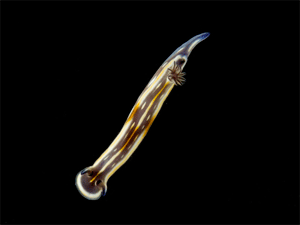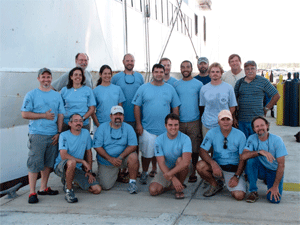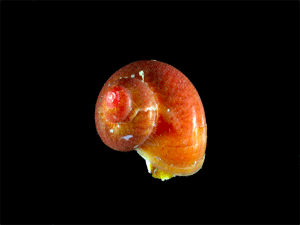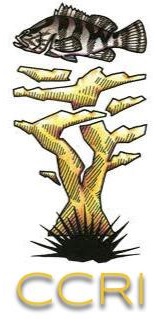A multi-site comparison on mesophotic reefs from Mona Island, PR to St. Croix, USVI
by Orian Tzadik
Jan 9th 2010 – We Embark
Location: Mayaguez
The project we are starting today opens a new page in the exploration of mesophotic coral reef ecosystems. These are systems that exist on the limit of the conventional photosynthetic zone in the marine environment. This is the first large scale effort to study these ecosystems, running across Puerto Rico and the US Virgin Islands. The team of scientists has been put together and sponsored in large part by the Caribbean Coral Reef Institute (CCRI) at the University of Puerto Rico, Mayaguez with the collaboration of the Cooperative Institute for Ocean Exploration, Research and Technology (CIOERT). The team includes faculty, staff and students from the University of Puerto Rico, as well as scientific crew members from the University of North Carolina – Wilmington and Florida Atlantic University, home of the CIOERT. This project is being conducted with the intent of providing information about these potentially fragile ecosystems and a base for future research on these reefs.
Our day started today at 8:30 at the marine research facility for the University of Puerto Rico. The trucks were loaded with equipment (rebreathers, dive gear, ROV), supplies (12 cylinders of pre-blended mixed gas, 700 lbs. of CO2 absorbent, alcohol and storage jars) and baggage. An hour later, the same team of scientists would load our home/laboratory for the next two weeks… the dive charter vessel, the Nekton Rorqual. The Rorqual was now set to sail on its epic journey.
To start off the Mesophotic Cruise, all hands reported to the Rorqual in the Mayaguez harbor. A well executed meeting determined our plans for the next day and a general outline for the next two weeks. All the necessary safety procedures were discussed as well as a general daily schedule. Our first stop will be Mona Island, 40 miles to the west of Puerto Rico. The Mona shelf system is very interesting; its isolation and unique morphology create a diverse ecosystem that will be used as a comparison to areas off southwest Puerto Rico already under study, as well as to our new locations to the East of Puerto Rico. I’m not sure what to expect yet, but I sense excitement in the air.
The Players
Mixed Gas Rebreathers:
- Dr. Clark Sherman (geology)
- Hector Ruiz (Phototransects, algae and corals)
- Michael Nemeth (phototransects, benthic collections, fishes)
- Ivonne Bejarano (fishes)
- Doug Kesling (Chief dive officer, video documentation)
- Milton Carlo
ROV Operators:
- Dr. Richard Appeldoorn (PI)
- Dr. Francisco Pagan
Film Crew:
- Efra Figueroa
- Dr. Michelle Scharer
Other Researchers and Assistants:
- Orian Tzadik – (fish, shallow diver, blogger)
- David Anderson (phototransects, corals, shallow diver)
- Dr. Joshua Voss (coral health, shallow diver)
- Dr. David Ballantine (algae)
- Dr. Nick Schizas (invertebrates, shallow diver)
- Dr. Matthew Craig (fish, shallow diver)
- Scott Fowler (Monitor daily diver operations)
Jan 10th 2010 – Let’s get wet
Location: South Coast of Mona Island
Quote of the Day (~7:00AM)
“Oh Dr. Ballantine, it’s always such a pleasure to start my day with the sun shining, and eating breakfast with you”
– Dr. Nick Schizas
Work starts early in the Rorqual. Today we awoke to a strong breakfast of bacon, eggs, waffles, fruit, toast and bagels. The day was calm and the seas were flat here at Mona Island. All was good aboard the Rorqual. The Rebreather divers were lined up and ready to go at 8:30 am as planned. “Dive! Dive! Dive!” shouted the captain over the intercom as we hit the drop point, and one by one the divers went over the side.
The team consists of six divers that are split into three buddy teams. Hector and Clark are responsible for the deep water photo transects. Ivonne is the deep team fish scientist while Doug is devoted to getting high definition videos of the dives. The last buddy team consists of Michael and Milton whose primary objective is to bring back representative samples. Just before leaving the bottom, divers send up the collected samples with a lift bag, which are picked up and whisked to Rorqual, where a team of scientists awaits. Today, Hector and Clark went down to 230ft, while the other two buddy pairs stayed at 160ft. As expected, the site was characterized by a wall that ran down to about 265ft (80 meters) before giving way to a sandy slope with large outcroppings covered in sponges. Reports of four lionfish came back with the deep divers, along with footage to prove it. The lionfish are endemic to the Indo-Pacific and have become an invasive species in the Caribbean. They are voracious predators and efforts are currently being made to eradicate them. By reporting such sightings, and taking action to remove the individuals, scientists are trying to limit the impact of these fish in the wider Caribbean basin.
The Remotely Operated Vehicle (ROV) went overboard next. With perfect conditions and experienced teams both driving/observing and monitoring the cable, the ROV deployment went off without a hitch. The geomorphology of the site was confirmed down to about 330 ft (100 meters); the outcrops previously described ceased below 80 meters after which the sand slope begins to dominate. The ROV operation for the day also scouted outcroppings to the west of the site that would be quantified the following day with photo transects by the deep diving team. In addition to confirming the lionfish reports, the ROV noted an abundance of blackfin snapper at the base of the wall. The recovery of the ROV went smoothly until the cable wrapped itself around the line of our nearby marker buoy. A quick jump in the water by a Rorqual staff diver to unwrap the buoy line cleared that right up.
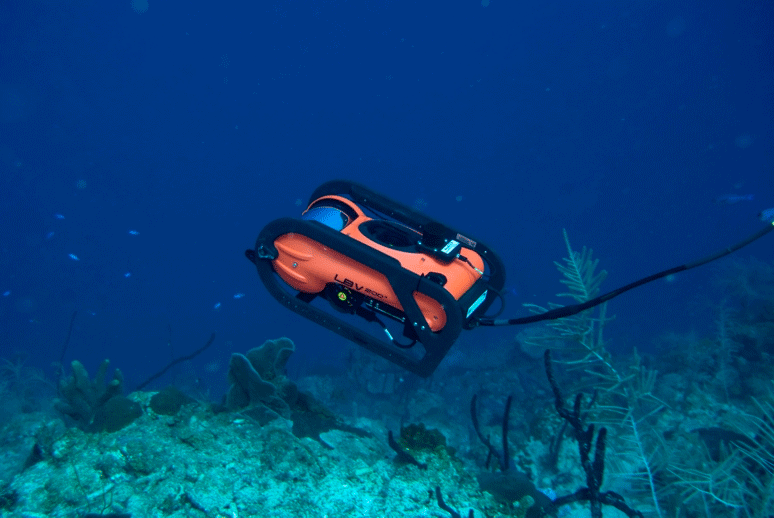
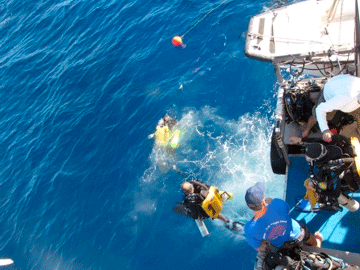
Two shelf break dives rounded out the afternoon, with teams duplicating the benthic phototransects and fish visual census transects done by the deep divers. All teams came back satisfied with work well done and plenty of data collected. The sea couldn’t have given us a better day and we were fortunate enough to take advantage. Great data, video footage and sample organisms were all part of a workday well spent.
As night fell we were treated to a stunning sunset before being welcomed into the Salon with dinner prepared by Renee and the Rorqual staff. A tired group of sunburned faces gathered for the evening briefing before one such face slipped off to write a blog.
Jan 11th 2010 – And then there were five
Location: South Coast of Mona
Quote of the Day
“I love the smell of Trimix in the morning…”
– Dr. Rich Appeldoorn
The rebreather divers are typically the first ones up. Preparing the rebreathers for the day’s dive is an exacting and time consuming process. Each diver must analyze trimix gases (oxygen, helium and nitrogen) to be used for the day’s dive. Gases are checked for both the rebreather’s tanks and the extra bailout bottles (in case of rebreather failure) that each diver must carry. The scrubber canister is then carefully packed with CO2 absorbent to have it set at the proper density and ensure a full supply; the canister is sealed. Next the rebreather pack is assembled, adding the gas tanks, canister and connecting the hoses and computers. When all is ready there are dive logs to fill and checklists to go through. The rebreather is now ready for calibration – the computers are set according to the previous gas analysis and tests are made to see that the computers and the three oxygen sensors are working properly. The final step is a 3-minute pre-breath to start the reaction between CO2 and the absorbent and to conduct a final check to see that all is functioning well.
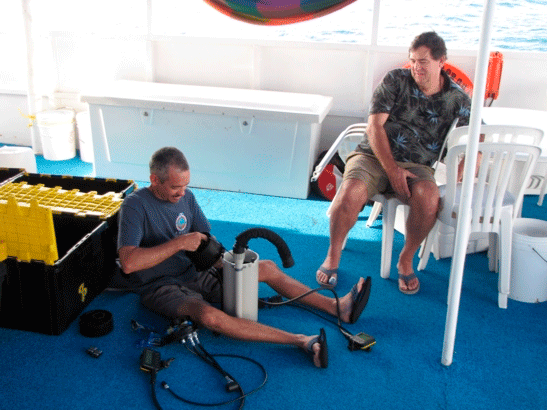
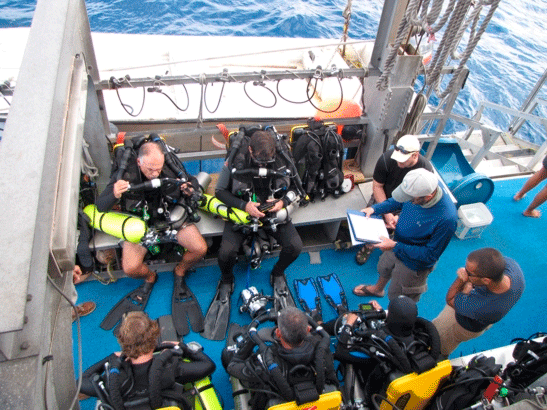
Joining the deep divers this early in the morning are Efra and Michelle, who set off in the Rorqual’s skiff to set up a 16-hour video camera with hydrophone. This “spag-cam” (for spawning aggregation) was placed at a grouper spawning site. Dr. Scharer intends to get video of pre-spawning behavior, including the sounds associated with such activities. Meanwhile, the Rorqual was off to today’s dive site, with glassy seas and dolphins playing in the bow wave. Then, following a final checklist gone through by Scott, our dive safety officer, off went the deep divers. An hour or so later, samples came up from the deep, including three lionfish. Exciting inverts filled out the collection bags and the buzz felt around the ship couldn’t be stopped. While the samples were all necessary for our studies, some concern was expressed that maybe there wasn’t enough of them. Future dives will aim to collect more samples. Then the divers came up.
One of the divers came up complaining of pain in the left shoulder, and fears of the bends pass quickly through the crew. Fortunately, we are well prepared for any contingency. Doug and Scott, who oversee the diving, brought a portable hyperbaric chamber (known as the human hotdog bag), which they are now forced to demonstrate –for real. The quickness and efficiency with which the operation was run was truly amazing. Everyone on board was given a briefing on how to work the chamber, and then our comrade was put inside. Using SCUBA tanks to cycle the air, and oxygen tanks for breathing gas exchange, the chamber has the effect of a large scale chamber, without the luxury of space. After 5 hours of decompression our teammate is back, pain free and walking around the boat and in high spirits. Unfortunately, as an additional safety precaution, he is officially deemed out of commission and will no longer be diving.
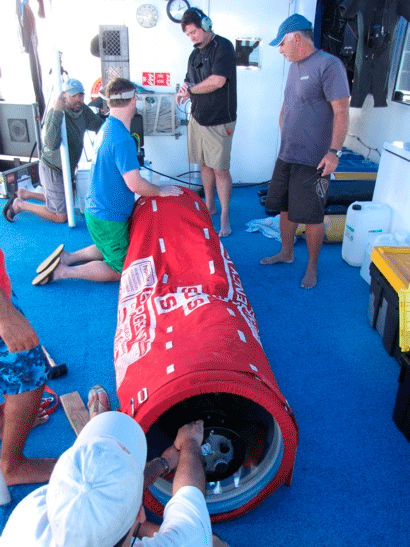
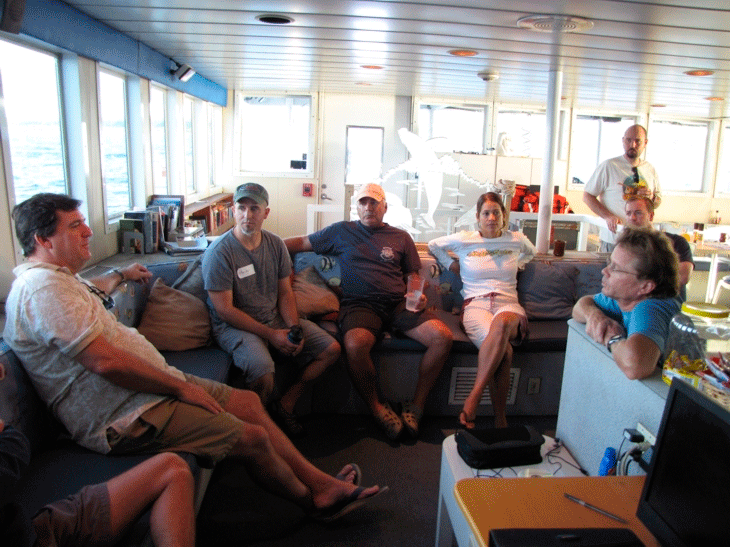
The rest of the day seemed to follow suit. The ROV dive was aborted due to ripping currents. The decision was then made to throw the shallow water divers in those same currents for transect work. One buddy team had to abort the dive after rapidly consuming air while battling the currents. The other two teams didn’t fare much better but were able to get valid data.
Tonight’s meeting was dominated by discussions on how to re-organize the deep diving teams and sampling plan, now that we are down a diver. Our Plan B will have all divers work at the same depth, with effort toward video documentation being shifted to conduct the phototransects. Our remaining diver trained in benthic work is put to fulltime collection. We also discuss the weather; a cold front is coming with swells and high winds expected.
Jan 12th 2010 – Chasing calm water
Location: West and South Mona
Today started out with a tough task ahead. The seas were angry and the wind forced the smashing waves against the bow of our ship. We tried to stick to the plan and collect data at our site on the northwest side of the island, but alas we were mistaken. Forced to move sites in search of calmer weather, the Rorqual headed to the southeast where the island would act as a barrier to the incoming weather. The prospect of losing the northwest site could be a considerable blow to our cause, as we will be unable to collect data from the north facing slopes of Mona Island.
We found what we came for and managed to get our deep team in at about 10:00AM. Sample bags came up almost without end. When sample bags get to the ship, the team waiting rushes into action. Samples of coral tissue need to be processed less than an hour after collection: they will be analyzed for their DNA, for their bacteria content to assess health and for gene expression as an indicator of stress. The DNA analyses will be used to determine the connectivity of populations across our sampling sites. Samples are also prepared for assessing reproductive activity. Taxonomists go through the samples while still fresh, looking for indications of new or rare species of algae or invertebrates. The fresh coloration helps with identifications. Today’s sampling was particularly successful. All targets were met for the site and a fine collection of invertebrates, algae and bottom samples was put together by the analysis team on the top deck. Even Dr. Ballantine had to admit to the quality of the algae that was brought up from the deep, including two species potentially new to science. Yet, we learn that the team missed their target depth (240 ft) and was shallower than anticipated.
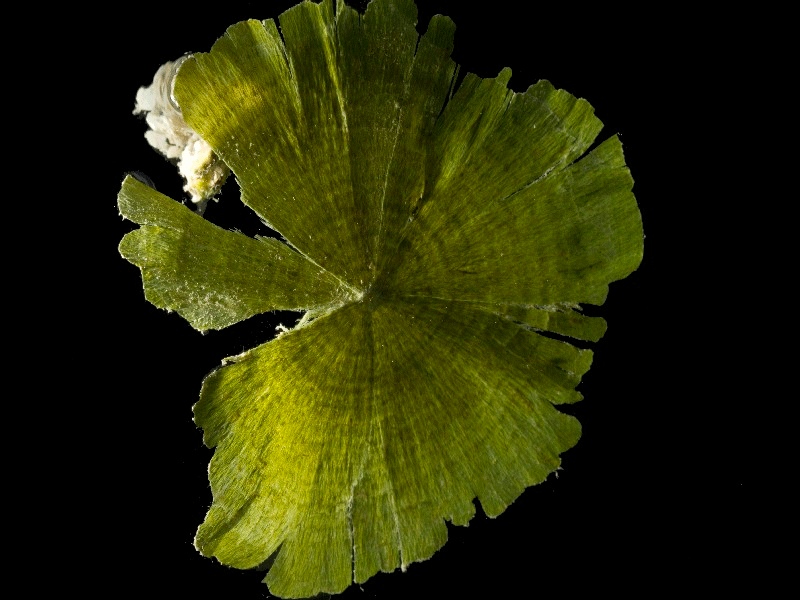
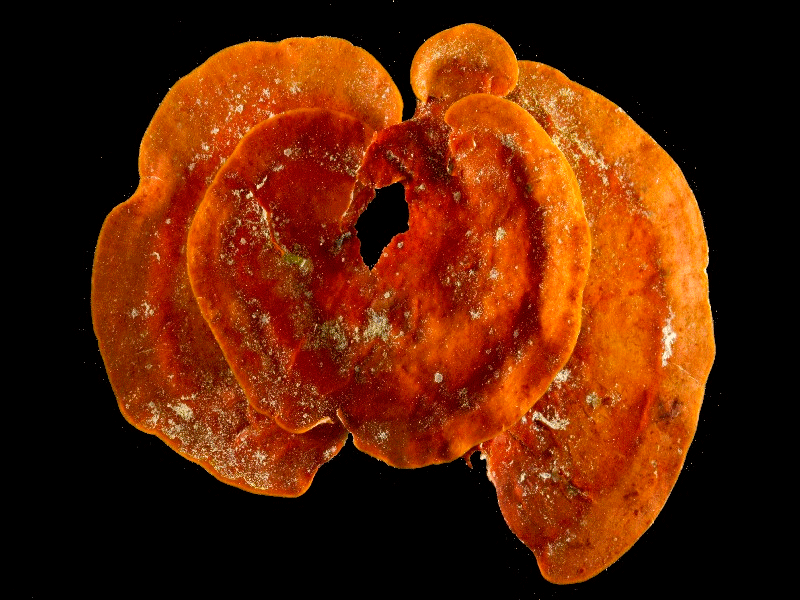
The ROV was next to test the waters and managed to execute its most successful dive yet this trip. With two hours of footage, the ROV captured images of lobsters, turtles, unusual coral morphs, sharks and groupers. The video was such a success that it was deemed an instant classic by the captured audience when showed that night in the salon. The success of the video and today’s diving, hinged on the extremely interesting ecosystem found. Abundant algae, corals, sponges and fish extended over a large area and reached depths of at least 250 ft (75 meters). Further exploration was not possible due to the length of cable for the ROV, but divers will return to the site tomorrow for a deeper dive. The success of this ecosystem at such extreme depths remains a mystery. Similar ecosystems have not yet been observed in the La Parguera region. One possible explanation might be the lack of sediment input to this region of the reef.
Michelle went off to recover the spag-cam, and the day rounded out with a shallow dive at the same location. Even though the current picked up fiercely at the end of the dive, the team managed to get its work done efficiently. The most interesting observation on the dive were the hundreds (possibly thousands) of flamingo tongue gastropods systematically eating the gorgonians (sea fans) in the area. With affirmation that yesterday’s long term spag-cam video was able to collect data, the day that started bleak and dreary turned out to be a complete success.
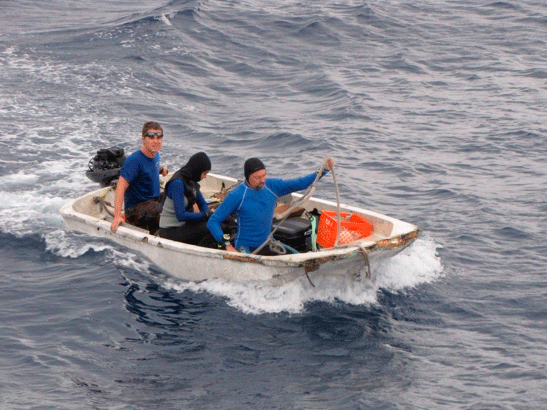
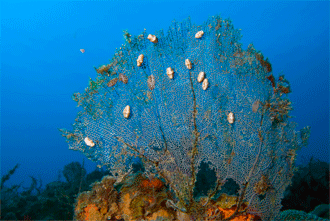
Jan 13th 2010 – Return to flat seas, well… sheltered anyway
Location: South Coast of Mona
Quote of the Day
(Speaking while fixing a dive computer): “Well, now I know that I can suck seven feet worth of pressure”.
– Dr. Matthew Craig
Today started with optimism and excitement… not to mention lessons in new dive computers. The recent events have reminded all of us that we are at the mercy of the equipment that gives us access to the depths, and we redouble our efforts to maintain them in good condition. Michelle is again off early to deploy the spag-cam, while the ship gets ready to return to our deep site. The deep diving team splashed at about 8:30AM. The plan for today was to get down deeper on the plain that was explored yesterday. Again, collections came up by the bagful and I’ve just been informed that we’ve now filled most of our quotas for Mona Island. “Hooray!”… An echoed sentiment from Dr. Nick Schizas as we are uncovering many unidentified species. Hector Ruiz has taken on the role as specimen photographer and has documented some exciting invertebrates with his wonderful photos. One in particular of a small unknown crab and another of a nemertean worm have awed the scientific crew on board.
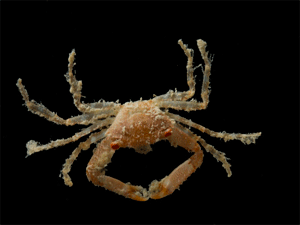
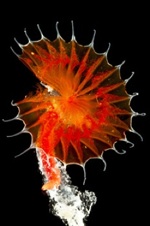
After a brief transit back toward the southwest to Carabinero, the ROV was deployed to explore a new area. Our new site was characterized by a near vertical wall from 90 to 240 ft, with an abundance of blackfin snappers at the base. Sand and rubble extended from the base, and hardbottom outcrops (also with blackfin) otherwise surrounded by sand were found from 270 to 290 ft. Below that, just sand extending off into the distance could be seen. The shallow dives at the top of the wall found the shelf break abundant with fish life and a vibrant substrate. Sponges, corals, soft corals, you name it, this site had it. My particular favorite was the schooling yellow goatfish that didn’t seem to mind my coming and going, but the field of garden eels came a close second. Unfortunately, more lionfish were observed. While many flamingo tongues were also observed to be impacting the gorgonians at this site, the corals were abundant, diverse and seemed healthy, providing ample structure and fish refuges.
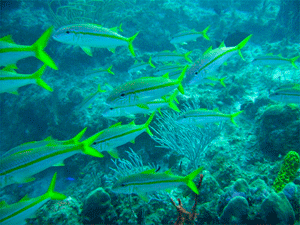
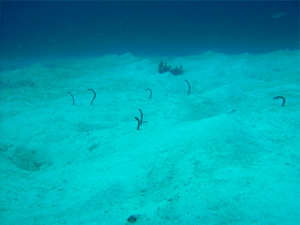
Jan 14th 2010 – With Mona in the rearview mirror
Location: Southwest Mona
Quote of the Day
“I want to make sure we preserve the corals of the present, for the future in formaline”
– Dr. Nick Schizas
oday marked our last full day of diving at Mona Island. No problems were encountered even though the weather was bleak and rainy all day. We stayed on the southern side of the island and were thus protected from the worst of the weather. The deep dive at the Carabinero site in the morning produced more samples, these from the area of the deep outcrops. Along with samples of inverts and substrate, a couple more lionfish were brought up and dissected. This time, one blenny was found in one of the lionfish stomachs.
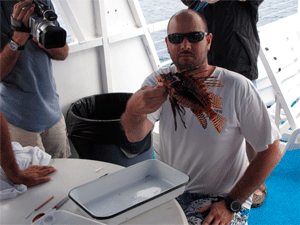
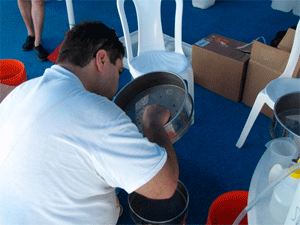
The ROV was next to explore yet another new site, The Elbow, at the southwest corner. The surface winds and currents made the trip a bit challenging, but as usual, the project was deemed successful after about an hour of footage. The ROV dive took place at another wall. Aside from the surface conditions, wall dives are particularly difficult for the ROV as the cable has ample opportunities to tangle itself in the epifuana that extend out from the wall. The surface conditions only amplify this as the wind pulling the boat will in turn pull on the cable. The wall itself was very interesting and filled with diverse corals, black corals and sponges. Eventually the elements prevailed and the cable got wrapped in our marker-buoy line. A quick diver deployment was necessary to untangle the lines before any serious damage could occur.
The shallow divers were presented with the “challenge” documenting again one of Mona’s nicest sites. Once again we were spoiled with lush reefs, abundant fish, stingrays and the odd shark. The day ended with a briefing to help plan the ‘great escape’ – a 24 to 30 hour relocation to the shelf off of Vieques Island on the other side of Puerto Rico.
Jan 15th 2010 – Cruising
Location: In transit
Quote of the Day
“Are we there yet?”
– Everyone
Today began our epic journey across the Puerto Rican plateau. But first there is still work to be done. We started the day with our last rebreather dive in Mona, along the wall at Carabinero. Sampling along a wall is difficult; transect lines have to be draped over small sponges or other invertebrates, and photo quadrat frames have to held at all times to keep them from falling down the precipice. After the dive, we returned to the northwest site to pick up a couple marker buoys we left; however nothing could be found. On the way off Mona we made a quick stop to pick up the spag-cam, then we were on our way. Nothing but wind and waves ahead of us. The captain has told us that under perfect conditions the crossing would take 24 hours… but conditions were far from perfect.
The samples brought up from the deep were once again of high quality and very interesting. So far, hundreds of samples from algae to corals to microscopic crustaceans have been classified and stored. Some corals have been documented at depths of 100 meters, possibly setting new records for known habitats in the Caribbean.
As the second half of the cruise looms, everyone on board is grateful for the opportunity to relax and gear up for some new spots and exciting opportunities. We’ll see how it turns out.
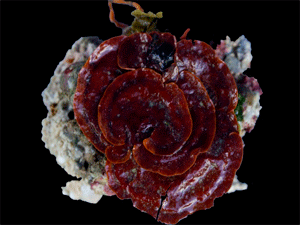
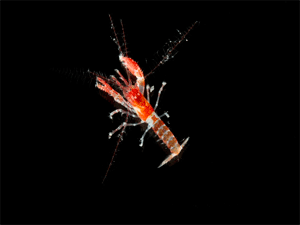
Jan 16th 2010 – Arrival
Location: ‘El Seco’ – Southeast of Vieques
Quote of the Day
“Well, I’d have to say that my primary objective on this cruise is to discover and describe genetic connectivity between crustaceans. But my second objective, and equally as important is to spend quality time with my colleagues”
– Dr. Nick Schizas
Today we arrive to the Vieques shelf. The crossing ended up taking about 26 hours and not nearly as tumultuous as anticipated. Upon arrival at our spot we sent the ROV in to scope out the area. A successful dive was made to about 400 ft (125 meters), and the first ever bottom sample (a rhodolith) was taken with the ROV’s mechanical arm. Rhodoliths are encrusting algal nodules. These nodules are not attached to the substrate and the growth occurs on the side that is facing the sunlight. As the rhodolith rolls around, the growth occurs on different faces. Our sample came from about 300 ft (92 meters) and was cataloged among the rest of the samples. For the most part, the bottom was characterized by an abundance of rubble with occasional corals and sponges. However, a unique feature as a steep slope between 170 – 200 ft (50 – 70 meters) was characterized by an abundance of corals. According to the detailed, high resolution bathymetry available for this site, this feature potentially extends for over 5 km making this a key area of mesophotic coral development. Also of note was the observation of a rare ‘soft coral’ not yet seen on this cruise. The combination of the ROV video with further inspection of the bathymetric data convinced the principal investigators to move the deep dive site location for the following day to a site further west along the slope to confirm the extension of the observed mesophotic coral zone. The new site was also predicted to have less sand, which would theoretically increase the probability of finding diverse and abundant coral habitats.
The shallow divers were also sent into the water at a nearby location to check out an elevated platform at about 100 – 115 ft (30 – 35 meters). While little structure was observed, fish were definitely plentiful. A large school of about 300 yellow jacks seemed to follow the divers for the entire dive. The large sizes of the fish present, including groupers and cubera snappers, are probably representative of the low fishing pressures in the region, which is closed seasonally. Benthic samples were also taken along with a few coral samples.
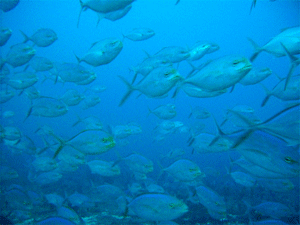
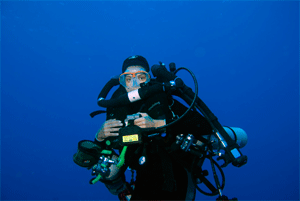
Even with the experience of being surrounded by hundreds of fish, I would have to say that the most exciting part of my day today has been taking a look into the microscopic world at a marine arachnid, a picnogonid, which is very rare indeed. The organism came off an algae sample taken from about 115ft (35 meters) and literally made Nick Schizas shout out in joy. All we can do from here on out is try to emulate that experience as best we can.
Jan 17th 2010 – An Angry Sea
Location: Eastern and Southern Vieques
Quote of the Day
“Fresh cookies everyday isn’t bad”
– Dr. David Ballantine
I am reminded that contributing to our success to date is the excellent service provided by the crew of the Rorqual, not the least of this is the fine and copious quantities of food provided by Renee and her staff. This allows the scientific crew to concentrate full time on the tasks at hand and greatly increases crew morale, something critical when we are tightly packed on the ship and must work in teams for both efficiency and safety. It also helps to keep spirits up when the seas turn against us.
The day started promising enough. Our rebreather divers made their first descent at El Seco, but winds and seas started to build. By the end of the dive, the winds had picked up and the sea rolled with waves of 5-7 ft. Rain clouds began to surround the boat just as the deep diving team was coming to the surface. All divers were brought on board successfully with the help of a motivated and dedicated crew. The site that was explored proved to be an interesting one. The divers were able to confirm the zone of corals observed by the ROV, and an exemplary sample set of algae was brought to the surface. The algae collected will have to be analyzed in the lab once we get home for further verification of exactly what was collected.
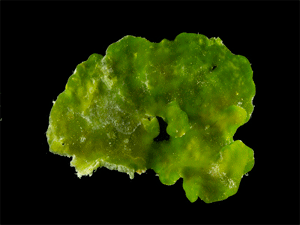
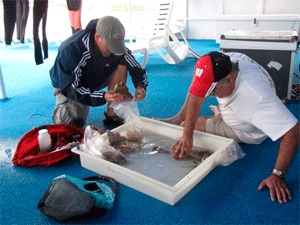
Unfortunately, the seas were deemed to risky for the ROV and consequently the shallow dive team as well. The Rorqual was forced to return to its mooring site, which provided some protection from the angry seas. Some adventurous divers went out once we moored up and were rewarded with abundant fish and a lush gorgonian reef.
Jan 18th 2010 – St. Croix on the Horizon
Location: Southern Vieques
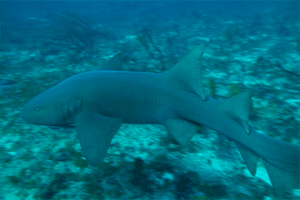
Forced to be flexible in the face of uncooperative weather, a new site was chosen near our mooring buoy along the Southern coast of Vieques. The site was only about 0.7 miles from our mooring site and took less than a half an hour in transit time. The new site was chosen as an interesting wall break that should have minimal sand deposits. The deep divers went in to survey the area blind, meaning that no ROV dive was deployed beforehand and that the divers did not know exactly what lay ahead of them. Fortunately, a very interesting zone presented itself starting at about 165 ft (50 meters). The divers collected adequate samples of mainly deep water corals, including the coveted Agaracia lamarckii. Doug Kesling captured on video a large strange looking nurse shark. This individual had a huge head, almost the appearance of a hump, and it had two shark suckers hanging on its underside. Also captured on video was a fish yet to be identified.
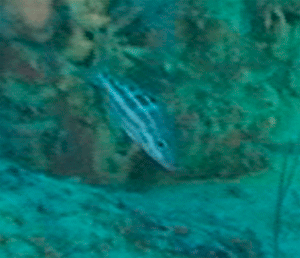
Once again, even at our more protected site, winds and waves continued to build, and the day’s remaining activities had to be aborted. Following the deep dive, we set out for the west coast of St. Croix. The crossing took six hours, and we moored in the Frederiksted harbor. A dive meeting determined the new plan that will be employed for St. Croix. With seas still expected to be high, we will be focusing our efforts on the northern coast of the island that has a shelf break very close to land, which should offer some protection. It is also more compatible with our need to return to Frederiksted by mid-afternoon for refueling the Rorqual. We hope to get all operations up and running bright and early tomorrow morning. In the meantime, the night was silent and still. Beautiful stars and a sliver of moon provided the entertainment after a fantastic sunset.
Jan 19th 2010 – What a day
Location: Northern coast of St. Croix
Quote of the Day
“It kind of looks like a lobster-shrimp… half lobster and half shrimp”
– David Anderson
Today started the same way the night had ended. Calm and beautiful in the harbor. For our revised target today, we have chosen a site in Cane Bay. The new site is sheltered and is locally known as a great (shallow) dive site.
The deep divers were treated to a beautiful slope of live and vibrant corals along a drop off down to 200 ft (60 m). Below this there was a vertical wall with a high sediment cover. Interestingly, this forced the deep divers to use their lights even in water with great visibility. The sun angle combined with the vertical wall actually shadowed the divers at depths of 230ft (70 meters), where divers were conducting their quantitative studies today. As always, samples came up of corals and substratum. One interesting organism that came up today was an unidentified shrimp. This shrimp was particularly interesting due to its unique tail morphology. The tail of the shrimp was highly modified, as it was disproportionably large and had no pigment.
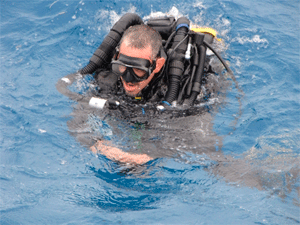
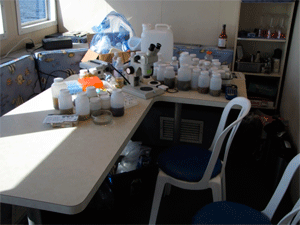
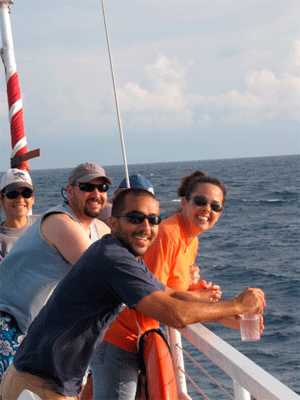
The ROV dive today verified the massive colonies of Agarcia lamarckii and A. undata that extended down to the top of the vertical wall. The colonies were so impressive, not only for their size, but also because of their health and abundances. The corals were bunched in large nodules that extended off the shelf. Very few (if any) were diseased or bleached and the documentation of such colonies is a great success for this cruise. The site in general was characterized by abundant and diverse corals. Large sponges were also abundant along the slope. Along the vertical wall the ROV found scattered sponges and black corals, and small caves with more varied fauna, including sclerosponges. The ROV entered one such cave at 255 ft to find a strange white sponge with stalks (possibly Siphonodictyon coralliphagum) on the cave floor and Baroque cave corals (Thalamophyllia riisei) along the top of the cave.
The shallow divers were sent into the water next and another transect dive was completed. The two fish transects that are required for each site have been collected, but one photo transect is still missing. We will have to come back tomorrow to finish the site and document the last photo transect. Tomorrow’s dive will most likely include some collections as well.
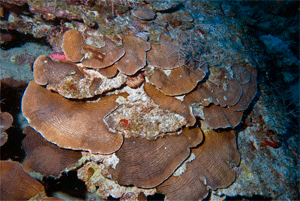
The appointment to take on fuel was at 4:00PM at the Frederiksted pier. For those adventurous enough, a highly rewarding night dive awaited under the pier. Described by Doug Kesling as the best night dive in the world, the Frederiksted pier night dive did not disappoint. Hundreds to thousands of crustaceans lined the sponges that have colonized each pillar of the pier. All sorts of invertebrates made themselves available for the extremely interested viewers. Extremely rare frogfish could be found on nearly every pillar while the occasional sea horse graced our presence as well. None were disappointed by a memorable dive under the stars.
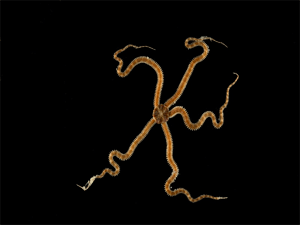
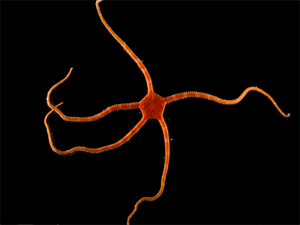
Jan 20th 2010 – Smooth sailing in the USVIs
Location: Northern coast of St. Croix and Buck Island
Quote of the Day
“The (popular) reef books only document all the sponges down to 130ft… looks like we beat that”
– Dr. Rich Appeldoorn
Our morning started back in Cane Bay. Again, the deep divers went down with the shallow divers following immediately afterwards. Today’s target was to quantify the magnificent coral habitat seen yesterday at 165 ft, but two of deep divers, Clark and Milton, split from the others on a mission to collect sclerosponges. These sponges are only found under deep over hangs or in caves, and they are calcareous. Calcareous sponges use calcium as a principal component of their body material. These sponges are of high interest because they are extremely old and can be used to extrapolate ocean conditions over the past several hundred years. By cutting the sponge at a cross section, the layers can be studied for evidence of rising ocean temperatures as a result of global increases in CO2. Thus, the highlight of today’s dive, and quite possibly Dr. Clark Sherman’s entire trip, was the collection of two sclerosponges from the deep. The other deep divers had no trouble collecting coral samples of the targeted species, Montastraea cavernosa and Agaracia lamarckii.
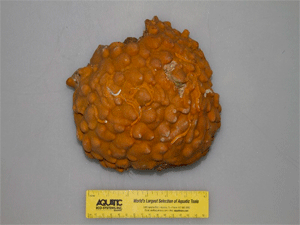
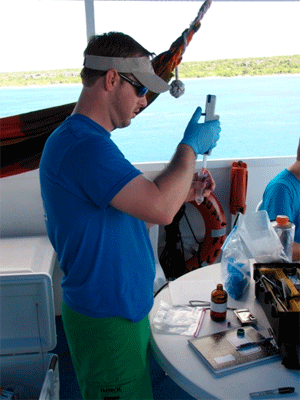
The shallow divers were able to complete the second necessary photo transect, as well as a fish rover survey and even a bit of collection. The mucus that envelops all corals was collected off of two more Montastraea cavernosa. The mucus off of such corals will be used by Dr. Joshua Voss in a bacteriology study. The roving fish study documented abundant snappers at the site as well.
After the shallow divers came out of the water, we moved over to the Buck Island National Monument to take a look at our original target site with the ROV. An hour long dive with the ROV documented a sparse slope dominated by sand. The video did manage to document three fish traps within the limits of this federal reserve area. These traps were most likely ghost traps, which are traps lost by fisherman but that continue to capture fish. These traps present problems as they are not managed by fisherman and can still have detrimental effects on fish communities. Ghost trap fishing has been well documented in previous studies as negatively impacting local fish populations. While the ROV did not detect any fish within the traps, the traps were being used by small juvenile blackfin snappers. A rock ledge found later, although still sediment covered, had a very high abundance of these same small juveniles, as well as other species, indicating the importance of the site as a deep nursery area.
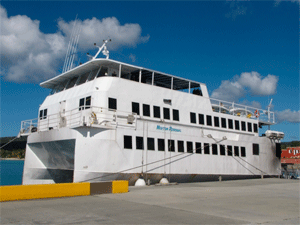
On the way back to the mooring site, a quick stop was made for shallow dives along the top of the Salt River Canyon. Some collections were done and the site was noted as being extremely biodiverse in both its fish and coral communities. Large snappers were regularly seen along the wall’s edge. In addition, healthy black corals were observed at depths much shallower than normal. Tonight we head over to Grammanik Bank off of St. Thomas. This will be the last leg of our trip before we head home to Fajardo after two more working days.
Jan 21st 2010 – St. Thomas
Location: Grammanik Bank
After our nighttime crossing from St. Croix to St. Thomas, we awoke on station at the Grammanik Bank. Part of the bank further west is a key aggregation site for spawning groupers and snappers. The edge of the back is rimmed by an elevated platform that may support abundant coral habitat. The rebreather dive team went down on the bank first thing in the morning. Surprisingly, there was not much structural habitat around, neither on top or at depth. The latter areas were characterized by a high abundance of rhodoliths with sand, but several larger fish were seen. These fish included snappers and even a large reef shark. The collections on the dive were dedicated to algae and loose components of the substratum. According to Dr. Ballantine, today was the most successful day in terms of algae.
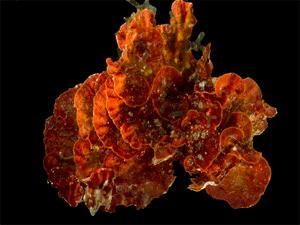
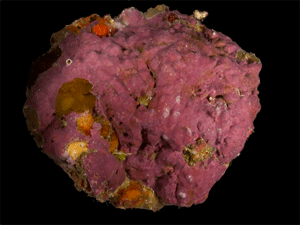
The ROV dive was also successful, providing an hour of video recording. This proved highly significant, as the video documented at key zone of coral development from 260-290 ft (80-90 m). This zone was below the depth visited by the deep divers the day before. The zone contained a high abundance of Agarica and Montastraea, with scattered colonies found down to 95 m, just before the slope turns into a wall. Another rhodolith was brought up from 290 ft, but was lost at the very end of the dive when the ROV was hauled out of the water. With the ROV footage from today, we now have video of mesophotic reefs in all of our targeted locations.
The shallow divers went into the water at about 1:30pm, targeting the raised shelf-edge platform, the top of which was at 100 ft. The benthic team managed to perform one photo transect, while both fish transects were completed even with the limited amount of bottom time available. While the smaller fish were not that abundant, many large fish were observed. One cubera snapper was recorded as 4 ½ feet long. The shallow water video team also observed three nurse sharks, a large black grouper and several large snappers.
Once the diving was finished for the day, the Rorqual made its way into Charlotte-Amalie harbor for the rest of the afternoon and the night. The plan is to head back out to the Grammanik bank at about 5:00 am to ensure that we will be ready to go with the deep divers at 8:30.
Jan 22nd 2010 – Aborted
Location: St. Thomas
Quote of the Day
“I would like to mention the camaraderie achieved on this cruise as a prime accomplishment”
– Dr. Nick Schizas
As planned, the Rorqual made it out to the bank, on time and ready to go. Unfortunately, the weather was not as sympathetic to our cause as we would have liked. The wind and the waves were deemed too strong to send in the divers or the ROV. Unexpectedly, the last day was cut short. The Rorqual came back into the harbor and the day was called.
As we returned to port, we all met to discuss the accomplishments of this cruise. Among others, we managed to document important new areas of extensive development of mesophotic corals and associated species, including possible new species of algae and invertebrates, as well as observing two unidentified fishes. We have documented depth limits for several species of algae, corals, sponges and fish. We have also recorded several lionfish sightings, and consequently confirmed that lionfish have an established presence around Mona Island. Overall we have met many objectives of our cruise thus far. Only time will tell the full extent of the success derived from this cruise. Years of laboratory analysis will come out of this cruise, including the DNA and coral health studies, and the true objectives will only be met once all the analysis is complete. For now, we’ve done our part in the data collection and primary analyses for the Mesophotic Cruise.
The rest of the day is spent packing equipment and samples and finishing up reports prior to our planned arrival in Fajardo at 7 am the next morning. Plans for future cruises abound.
